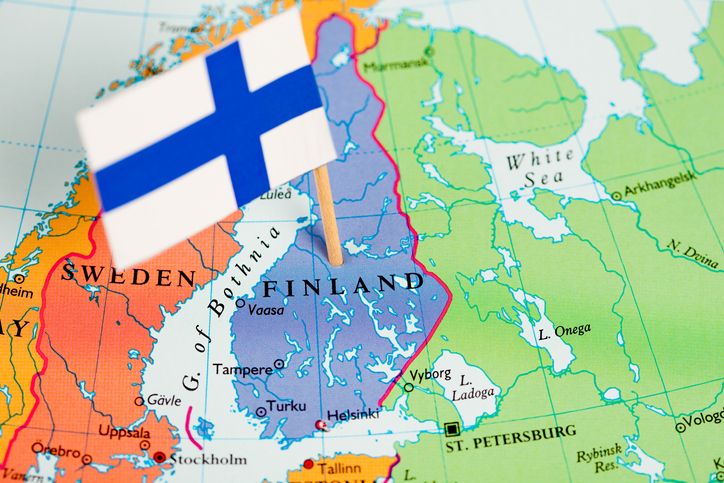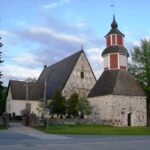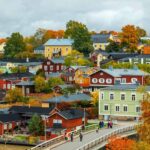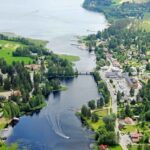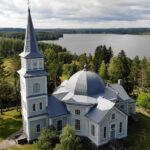Finland is located in the Fennoscandia geographical region in northern Europe. The total area of this country is approximately 130,128 square miles, with water covering around 10% of Finland, including nearly 188,000 lakes. Forests make up 69% of the total land area in Finland, of which 8% is used for agriculture. Finland shares land borders with three independent countries, including Russia, Norway, and Sweden (Finland’s neighbors). Finland’s land border stretches 1,593 miles, while its coastline is approximately 780 miles long.
The climate of Finland is influenced by various factors, with northern regions experiencing long winters and southern coasts having long summers. The most significant part of Finland’s economy is services, followed by manufacturing. Finland’s main export products include electrical equipment, optical instruments, transportation, and machinery.
With a population of only 5.52 million people (in 2019), Finland is one of the least populous countries in the European Union. About half of the country’s residents live in the southern coastal region, which enjoys a more pleasant continental climate. Finland’s territory comprises relatively low-lying coastal areas, extensive coniferous taiga forests, and marshes in some areas. Mount Halti on the border between Norway and Finland is the highest point in the country, reaching 1,365 meters (4,478 feet).
Finland’s neighbors : Finland’s neighboring country to the east is Russia.
Russia is situated in Eurasia and is currently the largest country in the world, covering an area of 6,592,800 square miles, with an estimated population of 144 million people. Russia shares an 813-mile border with Finland in the west. The border between Finland and Russia was first established in 1920 and later refined in 1965. Russia shares land borders with 16 independent countries, including Finland, Norway, China, Ukraine, and North Korea.
Russia has vast stretches of plains in its southern regions, while its northern regions are heavily forested. Mountain ranges are scattered along the southern borders, and the Caucasus Mountains host the highest peak in Russia and Europe. Eastern regions include the volcanic Kamchatka Peninsula, which features the largest active volcano in Eurasia.
Russia has thousands of rivers and bodies of water, with the largest being Lake Baikal, known for its depth, age, and purity. The country possesses vast natural resources, with the majority of its exports consisting of oil and natural gas, accompanied by metals and alloys. Russia is a regional power and is considered a potential superpower. It holds the largest stockpile of weapons of mass destruction and is one of the recognized nuclear-armed states.
Finland’s neighboring country is Norway.
The name “Norway” is derived from the Old English word “Norpweg,” which means “the northern way.” The Kingdom of Norway was established in 872 through the unification of several small kingdoms. Norway has a land border with Finland to the northeast, extending for 457 miles.
The border between Finland and Norway, as well as the one with Sweden, was established in 1751 through a treaty. Norway shares borders with Sweden, Finland, and Russia. As of December 31, 2017, Norway had an estimated population of around 5 million people. Norway is characterized by its mountainous or hilly terrain, making it one of the most mountainous countries in Europe.
The Scandinavian Mountains form a significant part of its border with Sweden. Norway has an intricate coastline with approximately 50,000 islands. The country boasts vast natural resources, including oil, fish, and minerals, and it is one of the world’s largest exporters of fish. In 2014, Norway made headlines by banning deforestation to protect its forests, becoming the first country to do so. Norway has one of the highest standards of living in the world.
Finland’s neighboring country is Sweden.
Sweden shares borders with Finland to the east and with Norway and Denmark as well. The name “Sweden” is derived from the Old English word “Sweopeod,” which means “the Swedish people.” Sweden is the largest country in Northern Europe and covers an area of 173,732 square miles. The border between Finland and Sweden extends for 339 miles and was established through the Treaty of Fredrikshamn in 1809 when Sweden ceded Finland to Russia.
As of December 31, 2017, Sweden had a population of 10 million people. Sweden is a country with extensive forests, covering 69% of its land area and housing nearly 95,700 lakes. The mountainous region of Sweden is primarily located in its northern and western parts. In the southern part of this mountainous region, you’ll find the traditional heart of Sweden, which is densely populated. Sweden’s economy is export-oriented, and it is worth noting that Sweden is among the world’s largest arms exporters.
Sweden excels in various national performance measures, such as quality of life, education, healthcare, and human development.
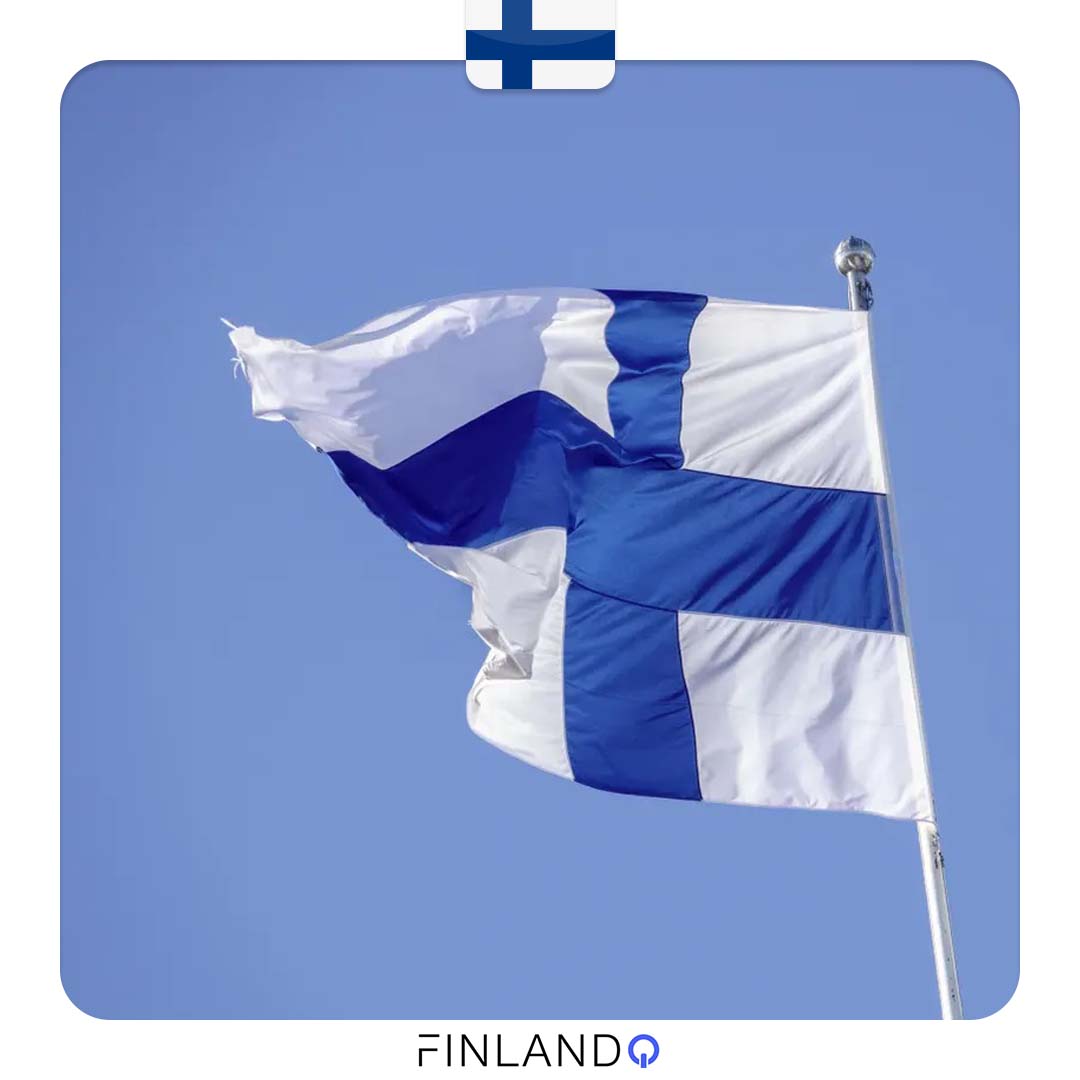
Foreign Relations of Finland
The foreign policy of the Republic of Finland primarily focuses on maintaining political and territorial integrity. Finland adheres to a policy of neutrality and maintains good relations with many countries. The country also maintains warm relations with its largest neighbor, Russia. Finland is dependent on gas and electricity from Russia, while Russia is a significant importer of Finnish products. Finland is a member of the European Union and the United Nations.
Visiting Finland’s neighbors
Did you know that there are fascinating countries to visit near Finland that you can reach by train or leisurely cruises? Finland is the northernmost country in the European Union, but it not only borders the Baltic Sea, the Gulf of Bothnia, and the Gulf of Finland but also shares land borders with Sweden, Norway, and Russia. Are you ready to explore countries that are easily accessible from Finland?
Finland’s neighbors : Estonia
You can travel from Helsinki to Tallinn, the capital of Estonia, in just 2 hours by a leisurely cruise. There are various options available from different ferry operators for traveling from Helsinki to Tallinn, each offering similar prices but differing services. When you disembark, you will find yourself in the heart of the Old Town, which is one of the best-preserved medieval cities. This city has been well maintained and was registered as a UNESCO World Heritage site in 1997.
Finland’s neighbors : Russia
Can you guess how long it takes to travel by train from Helsinki to St. Petersburg? Only 3.5 hours and at a very reasonable price! In addition to the train, there are several other options, such as buses, cruises, and flights, for traveling to St. Petersburg. That’s why many people take a short trip to Russia over the weekend.
St. Petersburg is the second-largest city in Russia after Moscow and a major Russian port on the Baltic Sea. The city houses over 200 museums, with the largest, the Hermitage Museum, founded in 1764. If you want to witness an amazing concert or a splendid opera, we highly recommend checking out the Mariinsky Theatre as well.
Finland’s neighbors : Sweden
Sweden is the largest of the Scandinavian countries and is located in northern Europe. The capital city is Stockholm, which is also the most populous city in the Nordic countries. Numerous ferries operate between Sweden and Finland, making Sweden a very accessible country for visitors from Finland. The ferries connect four ports in Sweden with four ports in Finland.
Gamla Stan, the Old Town founded in 1252, is one of the best-preserved old cities in Europe and a central attraction in Stockholm. Several charming churches and museums, including the Royal Palace, the Swedish Parliament, and the Vasa Museum, one of the most famous maritime museums in the world, are ready to welcome tourists.
Distance Table Between Finland and Other Countries
Estonia: 372.1 km / 231.2 miles
Sweden: 431.1 km / 267.8 miles
Latvia: 564.2 km / 350.6 miles
Lithuania: 758.3 km / 471.2 miles
Belarus: 921.9 km / 572.9 miles
Norway: 936.1 km / 581.7 miles
Denmark: 1,115.6 km / 693.2 miles
Poland: 1,180.2 km / 733.3 miles
Czech Republic: 1,485.9 km / 923.3 miles
Germany: 1,511.1 km / 938.9 miles
Slovakia: 1,520.2 km / 944.6 miles
Ukraine: 1,542.6 km / 958.5 miles
Moldova: 1,621.1 km / 1,007.3 miles
Hungary: 1,687.1 km / 1,048.3 miles
Slovenia: 1,738.3 km / 1,080.1 miles
Austria: 1,749.2 km / 1,086.9 miles
Romania: 1,776.5 km / 1,103.9 miles
Serbia: 2,013.7 km / 1,251.3 miles
Bosnia and Herzegovina: 2,069.1 km / 1,285.7 miles
Bulgaria: 2,132.5 km / 1,325.1 miles
Montenegro: 2,176.2 km / 1,352.2 miles
North Macedonia: 2,273.1 km / 1,412.5 miles
Albania: 2,338 km / 1,452.8 miles
Greece: 2,553.1 km / 1,586.4 miles
The FinlandQ Consulting team can assess your specific situation and provide you with all the necessary information. Stay in touch with us.

